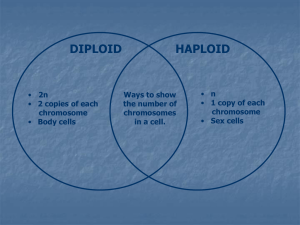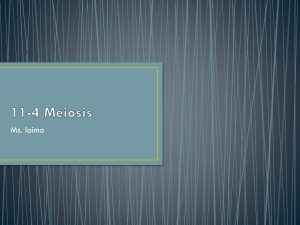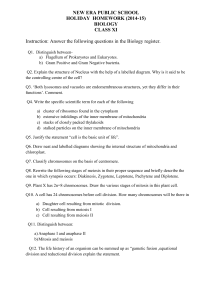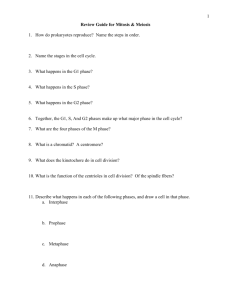Meiosis
advertisement
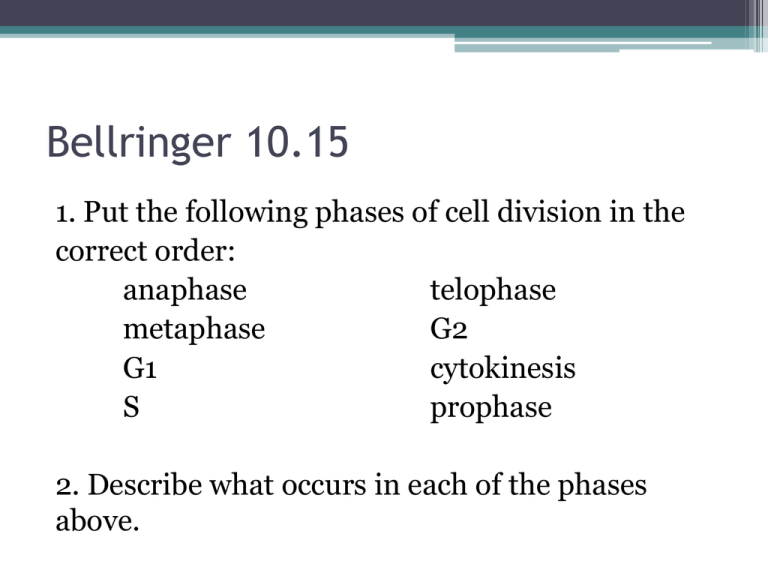
Bellringer 10.15 1. Put the following phases of cell division in the correct order: anaphase telophase metaphase G2 G1 cytokinesis S prophase 2. Describe what occurs in each of the phases above. Bellringer 4/29 1. Describe the phases of meiosis. 2. How does meiosis differ from mitosis? G1 S G2 P M A T Cytokinesis Sexual Reproduction Sexual reproduction • Uses genetic information from more than one source • Offspring are different from parents (lots of variation because of genetic recombination) • May use gametes (sex cells) Advantages • When an environment is changing an organism group (species) may be able to adapt because so much variation Disadvantages • When an environment is stable, variation is not as necessary • Reproduction cannot occur as quickly as asexual How are gametes made? ... MEIOSIS • Cell division that reduces the number of chromosomes in half • Makes haploid cells from diploid cells • Produces gametes (sperm and egg) Interphase • Period of cell growth and chromosome replication • Precedes meiosis Steps of Meiosis Meiosis I • 4 phases: P I, M I, A I, T I Prophase I: • Nucleolus and nuclear membrane fade, chromatin condenses and becomes chromosomes • Homologous chromosomes pair up (called synapsis). ▫ Homologous chromosomes = chromosomes that have the same type of genes (one from each parent) During synapsis, CROSSING OVER occurs • Homologous chromosomes cross over each other ▫ Exchange of genetic information ▫ Produces genetic recombination, which increases variations in offspring Metaphase I: • Homologous chromosomes line up in center of the cell Anaphase I: • Homologous chromosomes separate Telophase I: • Nuclear membrane reforms RESULT: TWO haploid cells Meiosis II: • Separates the copied chromosomes • 4 phases: P II, M II, A II, T II • RESULT: FOUR haploid cells PROPHASE II: • Nuclear membrane and nucleolus disappear, chromatin condenses into chromosomes, centrioles appear METAPHASE II: • Chromosomes line up at center of cell ANAPHASE II: • Centromeres break at center of chromosomes, chromosomes are divided into two chromatids; chromatids are pulled to opposite poles of cell TELOPHASE II: • Nuclear membrane and nucleolus reappear, chromosomes uncoil into chromatin Trait Mitosis Chromosome Number Same (diploid) Half (haploid) Genetic Similarities Same Diverse Type of Cell Somatic cells (any cell other than sperm/egg) Sex cells (egg & sperm) Number of Divisions 1(one) I and II (two) Type of Reproduction Asexual Sexual Role/Function Produce cells for growth & repair Meiosis Produce sex cells April 28, 2015 • Bellringer: 1. List the phases of mitosis in the correct order and describe what occurs in each phase. • Read section 10.2 (pg 263) in the blue Biology book. • Answer section questions 1-4 (pg 273) • Define the review and new vocabulary (pg 263) TO TURN IN! Mendel’s Pea Plant Experiment Questions 1. If the round seed shape is dominant to the wrinkled seed shape, what would the genotype be of the parent plants in the P generation of the cross between pure round seeds vs pure wrinkled seeds? What are the possibilities of genotypes in the F1 generation? F2 generation? 2. Repeat #1 the green/yellow cross, purple/white cross, and the tall/short cross. 3. What is the ratio of: 1. 2. 3. 4. Round : wrinkled green : yellow Purple : white Tall : short

